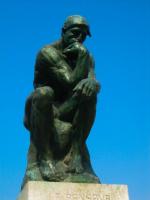Analysis of La Piedad (Vatican Piety) by Michelangelo
The Pieta of the Vatican is a sculptural work of the Italian Renaissance created by the Florentine artist Michelangelo Buonarroti in 1499, when he was just 24 years old. It receives this name because the work is currently in the Chapel of the Crucifix, of the Basilica of Saint Peter in the Vatican.
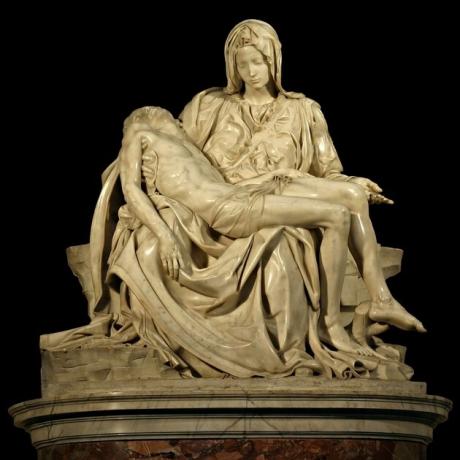
Also known as the Pieta of Michelangelo, this sculpture is a masterpiece of art history, which earned Buonarroti the growth of his fame. The sculptor surprised everyone in two respects. The first, his brilliant mastery of sculptural technique in his tender youth. He demonstrated that mastery in the way of working the marble, in the natural dimensions of the piece and in the composition, when he was just 24 years old.
Regarding the second aspect, Miguel Ángel stood out for his ability to challenge artistic tradition, by representing Mary younger than Jesus and without visible signs of suffering. That is why it is fair to ask what meaning is hidden behind Michelangelo's Pietà.
Characteristics of the Michelangelo's Vatican Pietà
The Pieta of the Vatican or Pieta of Michelangelo It is a sculpture of a round shape. It represents the moment in which the Virgin Mary receives the body of Jesus and holds it in her arms, just before the so-called lamentation over the dead Christ or planctus.
The main characteristics of this sculpture result from the solutions that the artist found for the treatment of the composition, the material, the dimensions and the figures.
Material
The piety It is a monolithic piece, that is, it is made from a single block of white marble extracted from the Carrara mountains, in the Tuscany region.
It is said that Michelangelo went personally to Carrara to choose his marble blocks. Among all the quarries available at the time, there was a vein that gave the palest marble, from which the sculptor had the block removed for the Piety.
This consideration explains why the work Vatican piety it has an almost uniform appearance, in which the veins of the marble practically do not interfere with the rendering.
Dimensions
The sculptural work Vatican piety It has dimensions of 195 centimeters wide and 174 centimeters high. It is a life-size work, which reinforces its realistic character to the viewer.
Composition

The piety It is classified as a whole or round sculptural ensemble. It is said that it is a sculptural set because it houses more than one figure, while the entire bulk means that it allows a visual movement around the piece.
The composition of the Piety it is based on an equilateral triangle on an elliptical base. This allows to develop the intention of providing the piece with balance and stability.
Figures (edit)
The composition of the Piety it is carried out by two figures: the Virgin Mary and Jesus Christ.
Jesus Christ
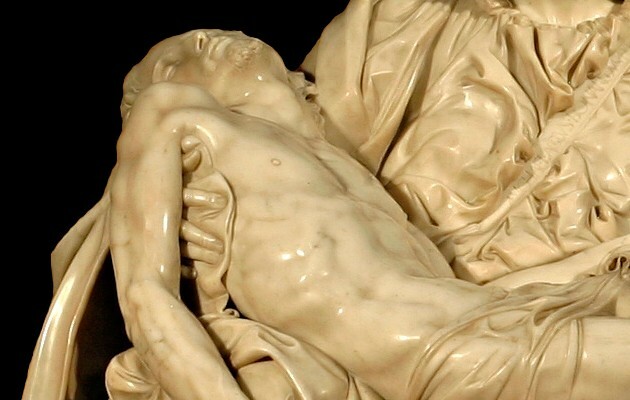
The figure of Jesus Christ, with his head and arm bent to the right side, harmonizes with the figure of the Virgin Mary, wrapped in thick fabrics full of folds.
The face of Jesus Christ, according to Michelangelo himself, represents a man incorporated into human nature, therefore common in his mortal remains. However, we do not see signs of pain in the figure.
Virgin mary
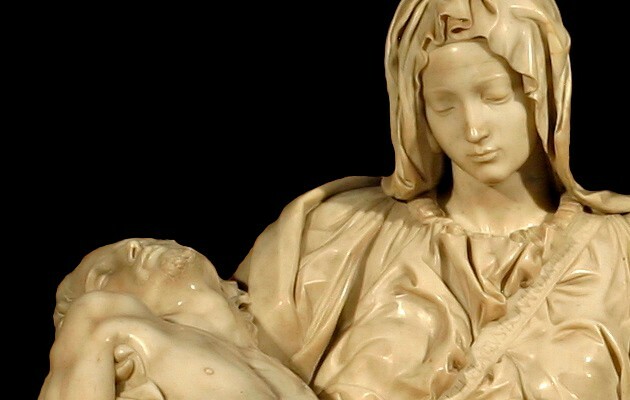
The monumentality of the Virgin Mary with respect to hers, her son, her Jesus Christ, serves as an element of optical correction to give balance to the sculptural ensemble. The proportions of her are also related to the leading character of the character in this piece. Maria is the center of attention for the viewer.
The character holds the body of Jesus on her lap. With his right hand he carries his torso, while the weight of the body is distributed on his legs. The left hand has the palm raised up, as in a sign of prayer.
The expression on his face shows no emotions. The direction of her head, outlined downward, makes us think that Mary is contemplating and meditating on the scene in her heart.
Technique and modeling
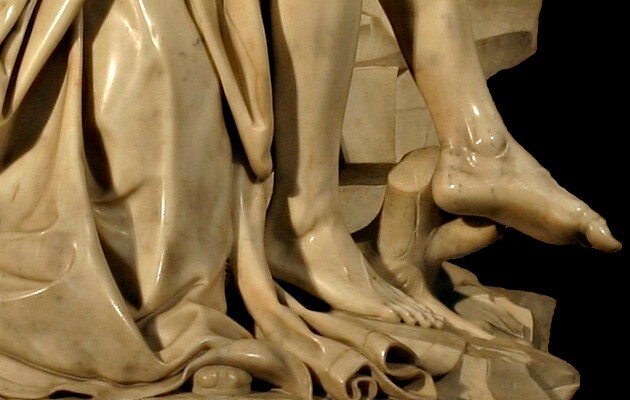
The different textures created through the different and meticulous modeling in each area are particularly striking. The marble in the Piety it has been modeled in different ways. The folds of the fabrics in the lower part of the work have greater volume, which gives stability.
The treatment of the drapery and its folds in the upper part is comparatively much smoother and more polished than the lower part. This allows the light to slide across the surface creating more delicacy.
Michelangelo's signature on the Vatican piety
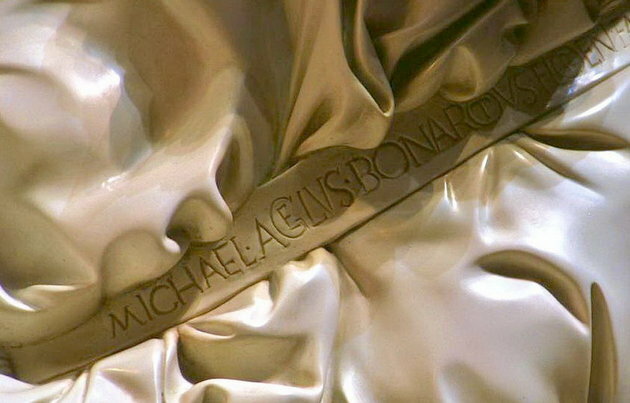
The piety it is the only work that Michelangelo signed. The reason is found in an anecdote told in Giorgio Vasari's book on The lives of the most excellent Italian architects, painters and sculptors.
One day, a rumor reached Michelangelo that a certain Gobbio from Milan had sculpted the magnificent work of the Vatican piety. Outraged by the false attribution, and in order to dispel any doubts, that same night Michelangelo engraved his name on the belt that crosses the breast of the Virgin Mary.
Analysis of the PietyMichelangelo's Vatican
The piety represents the devotion and lamentation of the Virgin Mary before the body of her son, Jesus Christ, after her death on the cross. The scene is not mentioned in either the canonical or apocryphal gospels. Perhaps for this reason, this scene began to be represented only from the fourteenth century, and was intended for private devotion.
The artists found their inspiration in the prophetic verses about the suffering of Mary (Lk 2, 33-35), the Gospel of Nicodemus (ch. XI), the revelations of the saints of the time, such as Saint Bridget, and the devotional texts.
The Pieta of the Vatican and artistic tradition
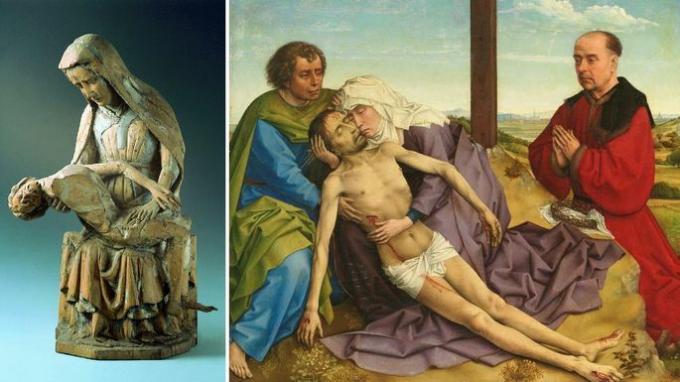
When Michelangelo sculpted the Vatican pietyRight at the end of the 15th century, there was already a plastic tradition of the piety scene. According to this, Mary was to be represented with her face aged by the blows of life and with visible signs of suffering.
At the beginning of that tradition, the body of Jesus used to be on a smaller scale. Over time, the proportion was adjusted and variants emerged that included characters on the sides.
However, Michelangelo did not do so. In addition to reducing the scene again to the two main characters (Mary and Jesus), Mary's expressions changed. Instead of looking old and suffering, she Vatican piety shows a young woman and owner of her emotions. Why does the artist represent it that way?
Serenity and balance in the face of pain

In sculpture Vatican piety, Michelangelo showed the influence of Neoplatonic philosophy and classical aesthetics. Such influence is embodied in making the Virgin Mary and Jesus Christ express serenity and balance, as well as an apparent absence of suffering.
In Michelangelo's sculpture, Mary is not the spoil of a suffering soul. Maria does not consent to become a victim or question her faith. On the contrary, he "carries" her reality, accompanies her son, contemplates the incomprehensible mystery of martyrdom.
Certainly, Mary is the protagonist of her composition, since the dull body of Jesus draws attention to her. Maria's body, her physical appearance, is in turn an image of the state of her soul that remains upright.
In fact, the extremely young face of the Virgin Mary was justified by Michelangelo as a way of symbolizing her eternal virginity. For Michelangelo, this was not strange. The artist genuinely thought that people who consecrated themselves to God body and soul were eternally "young."
Meaning of The Pieta of the Vatican
The way in which Michelangelo has represented piety means that harmony, balance and beauty become a metaphor for consecrated Christian spirituality. This spirituality is interpreted by the sculptor from a philosophical reading very typical of the Renaissance, which sees self-control as an element of reason and as a test of faith.
Maria's young and serene face becomes a visible sign of the character's inner reality, perhaps looking for a parallel with the Greco-Roman idea according to which a healthy "mind" is reflected in a body healthy. Mary is thus not only a Christian model, but a feminine embodiment of the humanist ideal of the Renaissance.
See also other works by Michelangelo:
- Sculpture of David.
- Sculpture of Moses.
- Fresco The Creation of Adam.
History of sculpture The piety
The Pieta of the Vatican or Pieta of Michelangelo it was commissioned by the Cardinal of Saint-Denis, Jean Bilhères de Lagraulas, whose purpose was to place it in St. Peter's Basilica in Rome.
As was customary in the Renaissance, the cardinal and the artist signed a contract in 1498. In this the material, the subject, the size, the terms and the price of the order were specified, which would be 450 ducats. The work would be made of marble, and it would represent the Virgin Mary on a natural scale, holding hers in her arms, her son, Jesus Christ who died of her.
According to the terms of the contract, the piece had to be completed in a period of no more than one year, and this was done by Miguel Ángel. However, Cardinal Jean Bilhères de Lagraula died a few days before, after which it was decided to place the statue on his grave. It took until the 18th century for the sculpture to be reassigned to St. Peter's Basilica.
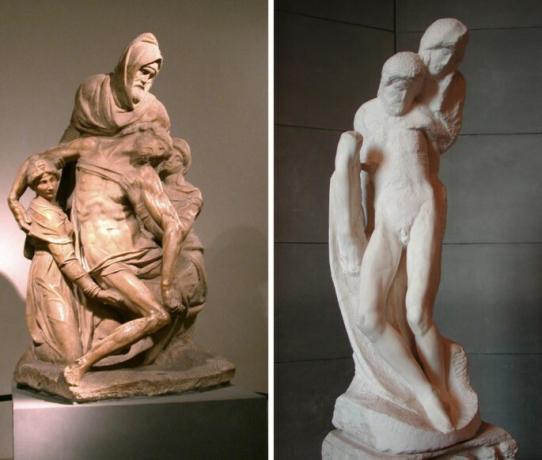
The Vatican Pietà was not the only sculpture in this scene made by Michelangelo. Years later, Michelangelo also sculpted two pieties that have attracted much attention from experts due to their differences with the famous Vatican Pietà.
It is about the Pietà of the Museo dell'Opera del Duomo and the Pieta Rondanini (incomplete), which can be found in the Sforzesco Castle in Milan.
Attack against Vatican piety
In the 20th century, the work suffered material damage due to an attack committed on May 21, 1972 by Laszlo Toth, a geologist of Hungarian origin who suffered from a mental illness.
In a crisis, Toth targeted the sculpture with a hammer and began hitting the sculpture while he screamed. The Virgin's nose, eyelids, left arm and elbow were broken. Fortunately, the damage could be repaired by a professional team.
References
Rodrigues Peinado, Laida: “Pain and lament for the death of Christ: Pieta and the Planctus”. Digital Magazine of Medieval Iconography, vol. VII, nº 13, 2015, pp. 1-17. Available in:
Vasari, Giorgio (1550, 2011): The lives of the most excellent Italian architects, painters and sculptors. Spain: Editorial Cátedra.

